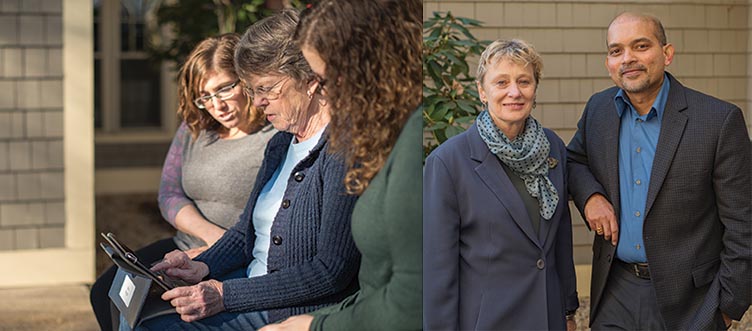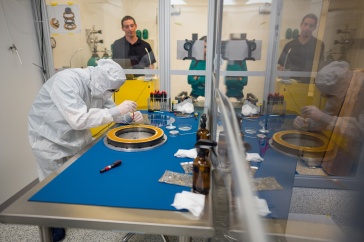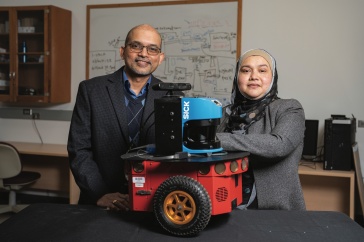
The world is getting older. In New England and throughout the United States, the gap between the young and the old has been steadily increasing since the 1950s. Statistics show that by 2030, one in five Americans will be older than 65. In New Hampshire, thanks to baby boomers, the older adult population will double during the next two decades. For seniors, their families and caregivers and policymakers nationwide, questions loom: How will they age? Where will they live? What will they need? Will there be enough resources to meet those needs? UNH researchers from across the disciplines are answering those questions, completing the picture of what aging in America looks like in the 21st century and creating knowledge that promotes healthy, happy aging for seniors and the communities that support them — and that they in turn support.
Kenneth Johnson, the Class of 1940 professor of sociology and senior demographer at UNH’s Carsey School of Public Policy, conducts demographic analyses that are being used to help states gauge future decision-making and policy changes. With the youngest and oldest citizens being the biggest consumers of such things as education and healthcare, changes in these populations will have significant implications on public services, particularly for older adults, he says. “Who’s going to take care of all these older people?” Johnson asks. “What will be the cost to the states? These are things that have to be addressed.”
What’s more, as these older adults retire, there will be less human capital to fuel continued economic growth. “In New Hampshire, for example, the slower growth of the working age population is a cause for some concern. It will have a big influence on state resources,” Johnson says.
On the flip side, Karen Smith Conway’s research reveals something that isn’t influencing resources in the way many states anticipated: older adults moving out of state because of state estate and inheritance taxes.

“The argument has been made for decades that the elderly move in response to these taxes, and this has driven a movement among states to get rid of estate taxes and grant or expand income tax breaks for the elderly,” says Conway, the John A. Hogan Distinguished Professor of Economics at the Peter T. Paul College of Business and Economics. “Our research has not found any evidence that there is a significant effect from these policies.”
Today, fewer than 20 states have estate and inheritance taxes, and every state with an income tax grants some kind of tax break to its senior citizens. In fact, since January 2017, at least 13 states have seen legislation aimed at eliminating or reducing taxes for the elderly. Yet Conway’s research shows that fewer than 1 percent of the elderly move across state lines in any one year.
Additionally, the tax breaks states are giving are often sizable, and as they continue to increase as the older population grows, state revenue will be further reduced. “Even if everyone did in fact move because of these taxes, the tax cuts would not pay for themselves,” she says.
An emerging area of research that impacts where older adults do reside has assistant professor of social work BoRin Kim exploring the associations between health changes and living arrangements among the elderly.
“Along with an aging population, understanding the factors contributing to successful aging in place becomes more important,” Kim says. “The impact on individual well-being and social costs is much greater than in the past.”
Kim has found that a diverse social network, home modification, community-based services and senior housing are all protective factors that help seniors maintain their physical, psychological and social well-being.
“Most elders prefer to stay in their home as long as possible,” Kim says, adding that doing so allows them to preserve social relations with their neighbors and continue to use resources in their community. Creating social programs and other interventions to help them age in place successfully, she says, could reduce social costs related to expensive health- and nursing home care.
With a major National Institutes of Health grant, Kerryellen Vroman and Sajay Arthanat, both associate professors of occupational therapy, are conducting a three-year study investigating the effectiveness of information communication technology (ICT) for older adults to promote healthy aging in place.
“Social isolation, loneliness and depression are challenges of later years, especially when mobility and health are impaired,” Arthanat says, adding that the program is designed for older adults who are least familiar with technology.
Based on a survey of more than 600 individuals, the project has UNH occupational therapy students working one-on-one with older adults in New England to provide home-based training aimed at improving skills — emailing with family and friends, taking photos or searching the internet, for example. The training also looks at how ICT use could progress and be sustained.

Additionally, the study will evaluate whether, with training, seniors will move to such practical functions as banking or ordering prescriptions online as well as examining their leisure use, an area that has borne unexpected results.
“One thing that we are pleasantly surprised by is how many people have enjoyed the recreation aspect — word games, Scrabble, Pinterest. While it is purely anecdotal information at this point, that has been really rewarding to see,” Vroman says.
Maintaining independence and health as we age often turns on a single, if surprising, physical factor: Leg strength. “We use our legs for almost anything we do — walk, get out of a chair, climb stairs,” says exercise scientist Summer Cook.
“Lower extremity function is what lets you live on your own,” adds Dain LaRoche, like Cook, an associate professor of kinesiology. LaRoche and Cook, working with graduate and undergraduate students, research how seniors can build and maintain that strength.
Cook is evaluating an alternative to traditional high-intensity resistance training with a regimen in which subjects lift very light weights while a cuff (much like a blood pressure cuff restricts oxygen to the muscle.
“This type of exercise is attractive as it can be used in clinical settings for patients with joint pain, arthritis or in post-surgery rehabilitation,” she says. “My research has shown that this blood flow-restricted resistance training can improve muscle mass and strength in older adults.”
LaRoche’s work aims to understand factors — biomechanical, neuromuscular and metabolic — that limit mobility in older adults. How does leg strength and power affect walking economy and fall risk, for instance, and what role does obesity play? “There’s a gap between life expectancy and quality of life in older age,” he says. “We can improve that a lot with physical activity.”
-
Written By:
Jody Record ’95 | Communications and Public Affairs | jody.record@unh.edu




















































